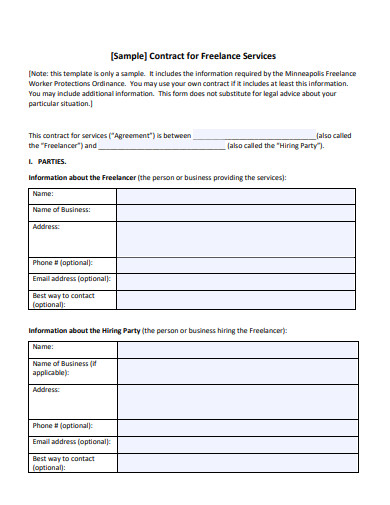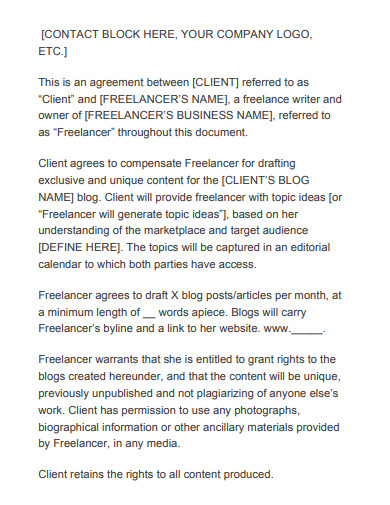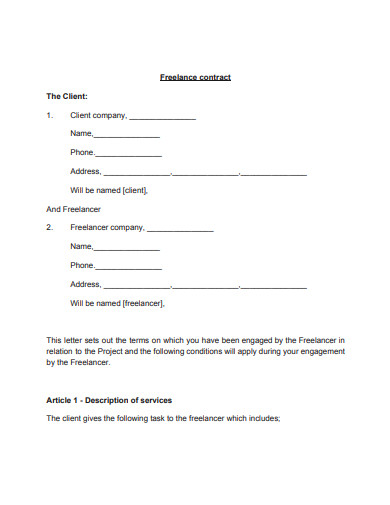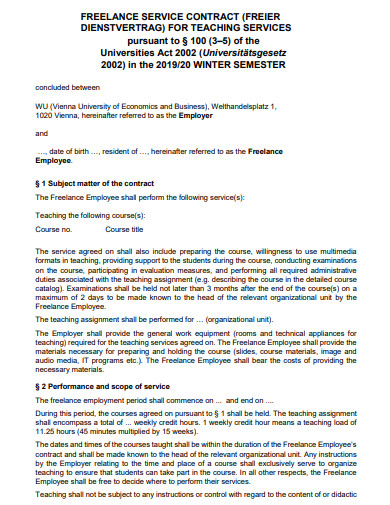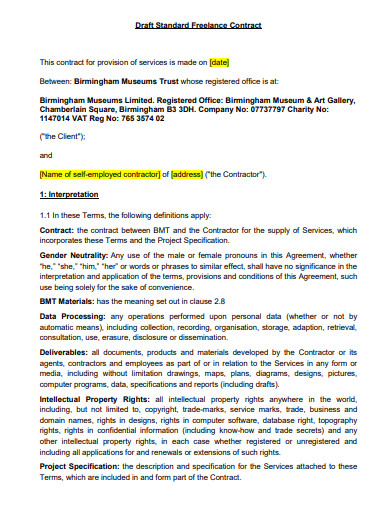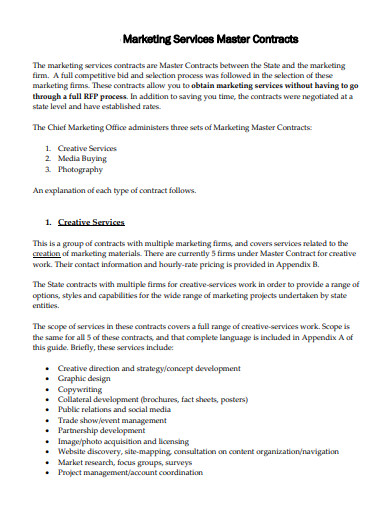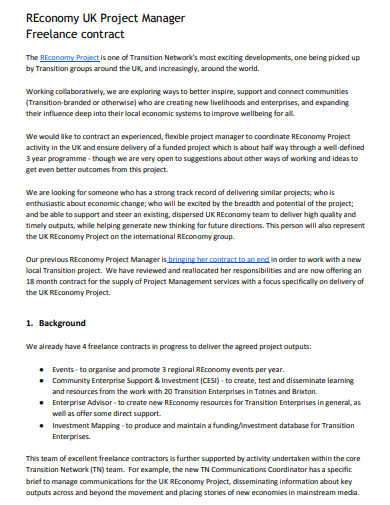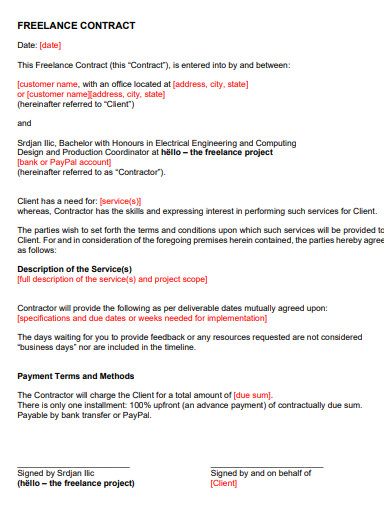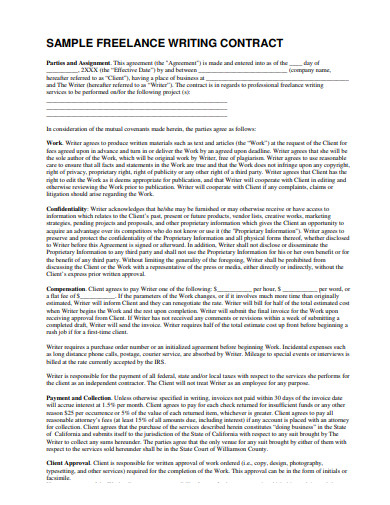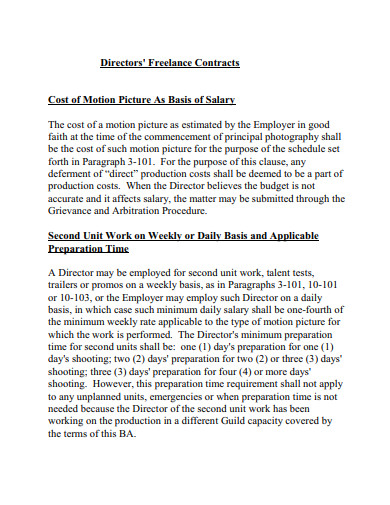We’ve all been there: you’ve found and vetted a fantastic freelancer, and all you want to do now is jump right into the work and start things rolling. Stopping to write and sign freelancing terms and conditions appears to be a waste of time. After all, the assignment should only take a few hours to complete, and the freelancer has a good track record, right? The truth is that it doesn’t matter how good a freelancer appears to be or how urgent the assignment is. It is critical to sign a formal contract when hiring non-payroll employees. Skipping it can have serious consequences and cause major problems for both you and the freelancer in the future.
10+ Freelancing Contract Samples
What is a freelancing contract? A freelance contract is a document that describes the parameters of a freelancer’s working relationship and is provided by an employer to the freelancer. It establishes explicit expectations for both parties for a certain project over a specific time period. This type of paper is legally binding and guarantees that everyone working on a project understands the service requirements. It is a mistake to begin a freelance employment relationship without a contract. A contract is in both your and your client’s best interests, and it has advantages. A contract is an agreement between two or more parties that is legally binding. It lets you identify what you’re doing, how much it’s worth, and who’s responsible for what.
1. Freelancing Contract
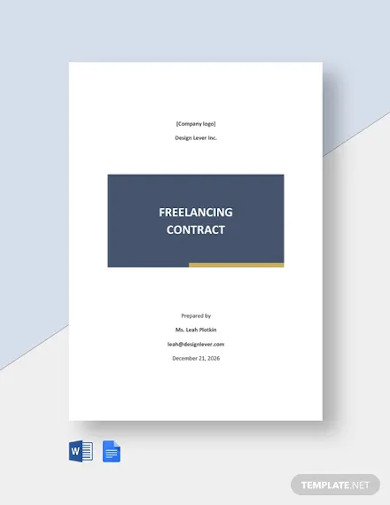
2. Contract for Freelance Services
3. Freelancing Client Contract
4. Sample Freelancing Contract
5. Simple Freelancing Contract
6. Standard Freelance Contract
7. Freelance Marketing Services Contract
8. Freelance Project Manager Contract
9. Freelance Contract Example
10. Basic Freelance Contract
11. Printable Freelance Contract
How to Write a Freelancing Contract?
- Description of work and services – Setting the work expectations during the project requires establishing a project scope inside the contract. Effective freelance contracts spell out exactly what you’ll do for the client and when you’ll do it. The more exact and detailed you can be when listing the contract’s activities, the better. Many freelancers suffer from scope creep, which occurs when the quantity of work on a project grows without a change in budget or remuneration.
- Payment terms – You have fulfilled a critical element of the freelance contract if you have performed all of the duties mentioned in the contract’s description of work and services. There’s nothing more frustrating than completing a project and not receiving immediate payment for the work you’ve done. As a result, it’s critical to establish specific payment terms in your freelance agreement. This section of the contract can include more information than just your hourly or fixed-project rate.
- End product ownership rights and licenses – This provision is frequently included by freelancers to establish who owns the work. Because the client is paying you to do the work, they will almost always demand that the work contract offer them full ownership and rights to all aspects of the project deliverables. If the client receives ownership rights, they can determine what they want to do with your work and how they want to utilize it. You’ll need to specify the client’s rights and usage terms if you retain ownership of some aspects of the work, such as proprietary software you produced. Depending on the type of labor and business, customary standards for end product ownership rights and licenses may vary.
- Terms and termination – If the partnership isn’t working out, including a termination provision or right to terminate in the contract creates a method for ending the freelance contract. Throughout the contract, either party may notice that things aren’t going as planned owing to a lack of communication, missing deadlines, or other factors. You can describe the grounds for termination as well as the costs or penalties connected with terminating the contract early in this section.
- Competitive engagements – It’s critical to emphasize to clients the exclusivity of your services as a freelancer. It’s possible that your client won’t want you to work with them while also assisting the competitors. Your expertise working with a client in the same industry but in a different geographic service area, on the other hand, could be considered as a plus. It’s advisable to spell out your policy for working with clients that may have services or business areas that overlap.
- Non-disclosure, right to disclosure, and confidentiality – It is critical to add a clause covering mutual non-disclosure of any secret information to safeguard both parties. You may obtain information about your client’s business as a freelancer that must be kept secret and confidential. Client lists, corporate plans, proprietary methods, secret recipes, financial information, and other types of information could be included. The client will want you to keep any confidential information to yourself. This clause may stand alone, or a separate and more extensive non-disclosure agreement may be required (NDA).
- Changes and revisions – You can define the fee you’ll charge for further edits or revisions in this area of the contract. To ensure that all parties are on the same page concerning changes to the project deliverables, it may be important to specify what constitutes a “round,” “edit,” or “revision.”
- Indemnity clause – Who is to blame if something goes wrong? Both parties will seek payment if the other party breaches the contract in this regrettable event. Indemnification, sometimes known as a keep harmless provision, is a clause that allows one party to shift potential expenses or responsibility to another in the event of specific events. An indemnification clause’s principal benefit is that it can shield the indemnified party from losses or third-party claims relating to the contract or outcomes coming from the contract’s activity or deliverables.
- General clauses – A general clause is used to cover any extra elements that are introduced to the contract. Legal disclaimers, safeguards, and other remarks can be included in this area.
- Party signatures – Both parties must agree to a legal contract in order for it to be valid. The most usual and straightforward way to establish this is to have both parties sign the contract. So, before you begin your next project, be sure that both you and the client have signed the document.
FAQs
What are other names for freelancing contracts?
- Client/Service Freelancer Agreement
- Company Contractor Agreement
- Contractor Agreement
- Freelancer Agreement
- Freelancer Contractor Agreement
- Independent Consultant Agreement
- Independent Contractor Agreement
What are the consequences of not using a freelance contract?
Without a freelance agreement, the freelancer’s expectations and needed services may be unclear. To avoid confusion or excessive effort, it is critical that both an independent contractor and their customer have a shared knowledge of the project’s scope.
While both parties want a favorable conclusion from their transactions, having a solid contract that explains the terms of your agreement with your customer is one of the greatest methods to defend your business in the event of a dispute. A freelance contract is an important aspect of starting and sustaining a company. You risk losing your clients’ trust and business if you don’t have it.
Related Posts
Sample Excuse Letter for School
Feature Writing Samples
FREE 10+ Security Guard Contract Samples in PDF | MS Word
FREE 10+ Option to Purchase Agreement Samples in MS Word | Apple Pages | PDF
FREE 26+ Curriculum Form Samples in MS Word | PDF
FREE 20+ Cleaning Service Proposal Samples in PDF | MS Word
FREE 29+ Sample Loan Application Form Templates in MS Word | PDF
FREE 10+ Event Venue Contract Samples in PDF | MS Word | Pages | Google Docs
FREE 10+ SBAR Samples in PDF | DOC
FREE 12+ Music Band Contract Templates in PDF | MS Word
FREE 10+ HVAC Maintenance Contract Samples in PDF | MS Word
FREE 10+ Social Media Marketing Contract Samples in MS Word | PDF
FREE 10+ Wholesale Assignment Contract Samples in PDF
FREE 18+ Financial Proposal Samples in PDF | MS Word | Google Docs | Pages
FREE 10+ Feasibility Study Samples in PDF

